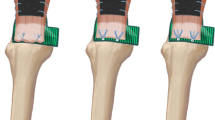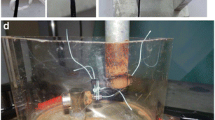Abstract
Purpose
Various stitching techniques have been described to facilitate arthroscopic repair of rotator cuff tears. The aim of the present study was to compare the biomechanical properties of the lasso-loop, lasso-mattress and simple-cinch stitch for rotator cuff repair.
Methods
Twelve infraspinatus tendons were harvested from sheep and split in half. The tendons were randomized into three different stitch configuration groups for biomechanical testing: lasso-loop, lasso-mattress and simple-cinch stitch. Each specimen was first cyclically loaded on a universal materials testing machine under force control from 5 to 30 N at 0.25 Hz for twenty cycles. Then, each specimen was loaded to failure under displacement control at a rate of 1 mm/s. Cyclic elongation, peak-to-peak displacement and ultimate tensile load were reported as mean ± standard error and compared using one way analysis of variance. The type of failure was recorded.
Results
No differences in cyclic elongation (1.31 ± 0.09 mm for the simple-cinch vs. 1.49 ± 0.07 mm for the lasso-mattress vs. 1.61 ± 0.09 mm for the lasso-loop stitch, p = 0.063) or peak-to-peak displacement (0.58 ± 0.04 mm for the simple-cinch, 0.50 ± 0.03 mm for the lasso-mattress and 0.62 ± 0.06 mm for the lasso-loop stitch, p = 0.141) were seen between all tested stitch configurations. In the load-to-failure test, the simple cinch stitch (149.38 ± 11.89 N) and the lasso-mattress (149.38 ± 10.33 N) stitch demonstrated significantly higher ultimate load than the lasso-loop stitch (65.88 ± 4.75 N, p < 0.001). All stitch configurations failed with suture pull out.
Conclusions
The lasso-mattress and the simple-cinch stitch showed similar biomechanical properties with significant higher tensile loads needed for failure than the lasso-loop stitch.





Similar content being viewed by others
References
Severud EL, Ruotolo C, Abbott DD, Nottage WM (2003) All-arthroscopic versus mini-open rotator cuff repair: a long-term retrospective outcome comparison. Arthroscopy 19(3):234–238. doi:10.1053/jars.2003.50036
Buess E, Steuber KU, Waibl B (2005) Open versus arthroscopic rotator cuff repair: a comparative view of 96 cases. Arthroscopy 21(5):597–604. doi:10.1016/j.arthro.2005.01.002
Scheibel MT, Habermeyer P (2003) A modified Mason-Allen technique for rotator cuff repair using suture anchors. Arthroscopy 19(3):330–333. doi:10.1053/jars.2003.50079
Castagna A, Garofalo R, Conti M, Borroni M, Snyder SJ (2007) Arthroscopic rotator cuff repair using a triple-loaded suture anchor and a modified Mason-Allen technique (Alex stitch). Arthroscopy 23(4):440 e441–440 e444. doi:10.1016/j.arthro.2006.07.046
Frosch S, Buchhorn G, Hoffmann A, Balcarek P, Schuttrumpf JP, August F, Sturmer KM, Walde HJ, Walde TA (2015) Novel single-loop and double-loop knot stitch in comparison with the modified Mason-Allen stitch for rotator cuff repair. Knee Surg Sports Traumatol Arthrosc 23(5):1552–1558. doi:10.1007/s00167-014-2976-7
Miyazaki AN, Zanella LA, La Salvia JC, Fregoneze M, Santos PD, da Silva LA, Sella Gdo V, Checchia SL (2014) Arthroscopic double-locked stitch: a new technique for suturing rotator cuff tears. Arthrosc Tech 3(2):e223–e225. doi:10.1016/j.eats.2013.10.002
Yamaguchi K, Levine WN, Marra G, Galatz LM, Klepps S, Flatow EL (2003) Transitioning to arthroscopic rotator cuff repair: the pros and cons. Instr Course Lect 52:81–92
Gartsman GM, Khan M, Hammerman SM (1998) Arthroscopic repair of full-thickness tears of the rotator cuff. J Bone Joint Surg Am 80(6):832–840
Guttmann D, Graham RD, MacLennan MJ, Lubowitz JH (2005) Arthroscopic rotator cuff repair: the learning curve. Arthroscopy 21(4):394–400. doi:10.1016/j.arthro.2004.12.006
Hawi N, Krettek C, Hawi A, Meller R (2015) The simple cow hitch stitch technique for arthroscopic rotator cuff repair and stabilization using knotless suture anchors. Arthroscopy Techniques. doi:10.1016/j.eats.2015.01.008
Lafosse L, Van Raebroeckx A, Brzoska R (2006) A new technique to improve tissue grip: “the lasso-loop stitch”. Arthroscopy 22(11):1246 e1241–1246 e1243. doi:10.1016/j.arthro.2006.05.021
Toussaint B, Schnaser E, Lafosse L, Bahurel J, Gobezie R (2009) A new approach to improving the tissue grip of the medial-row repair in the suture-bridge technique: the “modified lasso-loop stitch”. Arthroscopy 25(6):691–695. doi:10.1016/j.arthro.2008.11.002
Ponce BA, Hosemann CD, Raghava P, Tate JP, Eberhardt AW, Lafosse L (2011) Biomechanical evaluation of 3 arthroscopic self-cinching stitches for shoulder arthroscopy: the lasso-loop, lasso-mattress, and double-cinch stitches. Am J Sports Med 39(1):188–194. doi:10.1177/0363546510383394
Ma CB, MacGillivray JD, Clabeaux J, Lee S, Otis JC (2004) Biomechanical evaluation of arthroscopic rotator cuff stitches. J Bone Joint Surg Am 86-A(6):1211–1216
Hapa O, Barber FA, Sunbuloglu E, Kocabey Y, Sarkalkan N, Baysal G (2011) Tendon-grasping strength of various suture configurations for rotator cuff repair. Knee Surg Sports Traumatol Arthrosc 19(10):1749–1754. doi:10.1007/s00167-010-1322-y
Cummins CA, Murrell GA (2003) Mode of failure for rotator cuff repair with suture anchors identified at revision surgery. J Shoulder Elbow Surg 12(2):128–133. doi:10.1067/mse.2003.21
Matsen FA 3rd (2008) Clinical practice. Rotator-cuff failure. N Engl J Med 358(20):2138–2147. doi:10.1056/NEJMcp0800814
McElvany MD, McGoldrick E, Gee AO, Neradilek MB, Matsen FA 3rd (2015) Rotator cuff repair: published evidence on factors associated with repair integrity and clinical outcome. Am J Sports Med 43(2):491–500. doi:10.1177/0363546514529644
Le BT, Wu XL, Lam PH, Murrell GA (2014) Factors predicting rotator cuff retears: an analysis of 1000 consecutive rotator cuff repairs. Am J Sports Med 42(5):1134–1142. doi:10.1177/0363546514525336
Hawi N, Dratzidis A, Kraemer M, Suero EM, Liodakis E, Hurschler C, Krettek C, Hawi A, Meller R (2016) Biomechanical evaluation of the simple cinch stitch for arthroscopic rotator cuff repair. Clin Biomech 36:21–25. doi:10.1016/j.clinbiomech.2016.04.018
Park MC, Elattrache NS, Ahmad CS, Tibone JE (2006) “Transosseous-equivalent” rotator cuff repair technique. Arthroscopy 22(12):1360 e1361–1360 e1365. doi:10.1016/j.arthro.2006.07.017
Park JS, McGarry MH, Campbell ST, Seo HJ, Lee YS, Kim SH, Lee TQ, Oh JH (2015) The optimum tension for bridging sutures in transosseous-equivalent rotator cuff repair: a cadaveric biomechanical study. Am J Sports Med 43(9):2118–2125. doi:10.1177/0363546515590596
Montanez A, Makarewich CA, Burks RT, Henninger HB (2016) The medial stitch in transosseous-equivalent rotator cuff repair: vertical or horizontal mattress? Am J Sports Med. doi:10.1177/0363546516648680
Gerhardt C, Hug K, Pauly S, Marnitz T, Scheibel M (2012) Arthroscopic single-row modified mason-allen repair versus double-row suture bridge reconstruction for supraspinatus tendon tears: a matched-pair analysis. Am J Sports Med 40(12):2777–2785. doi:10.1177/0363546512462123
Shin SJ, Kook SH, Rao N, Seo MJ (2015) Clinical outcomes of modified mason-allen single-row repair for bursal-sided partial-thickness rotator cuff tears: comparison with the double-row suture-bridge technique. Am J Sports Med 43(8):1976–1982. doi:10.1177/0363546515587718
Christoforetti JJ, Krupp RJ, Singleton SB, Kissenberth MJ, Cook C, Hawkins RJ (2012) Arthroscopic suture bridge transosseus equivalent fixation of rotator cuff tendon preserves intratendinous blood flow at the time of initial fixation. J Shoulder Elbow Surg 21(4):523–530. doi:10.1016/j.jse.2011.02.012
Gerber C, Schneeberger AG, Beck M, Schlegel U (1994) Mechanical strength of repairs of the rotator cuff. J Bone Joint Surg Br 76(3):371–380
Needell SD, Zlatkin MB, Sher JS, Murphy BJ, Uribe JW (1996) MR imaging of the rotator cuff: peritendinous and bone abnormalities in an asymptomatic population. AJR Am J Roentgenol 166(4):863–867. doi:10.2214/ajr.166.4.8610564
Lewis CW, Schlegel TF, Hawkins RJ, James SP, Turner AS (2001) The effect of immobilization on rotator cuff healing using modified Mason-Allen stitches: a biomechanical study in sheep. Biomed Sci Instrum 37:263–268
Acknowledgments
Funding awarded by the Alwin Jaeger Foundation (Aschaffenburg, Germany) was used for all materials required for performing this experimental study.
Author information
Authors and Affiliations
Corresponding author
Ethics declarations
Conflict of interest
Each author certifies that he has no commercial associations (e.g., consultancies, stock ownership, equity interest, patent/licensing arrangements, etc.) that might pose a conflict of interest in connection with the submitted article.
Rights and permissions
About this article
Cite this article
Liodakis, E., Dratzidis, A., Kraemer, M. et al. The lasso-loop, lasso-mattress and simple-cinch stitch for arthroscopic rotator cuff repair: are there biomechanical differences?. Arch Orthop Trauma Surg 136, 1581–1585 (2016). https://doi.org/10.1007/s00402-016-2540-7
Received:
Published:
Issue Date:
DOI: https://doi.org/10.1007/s00402-016-2540-7




